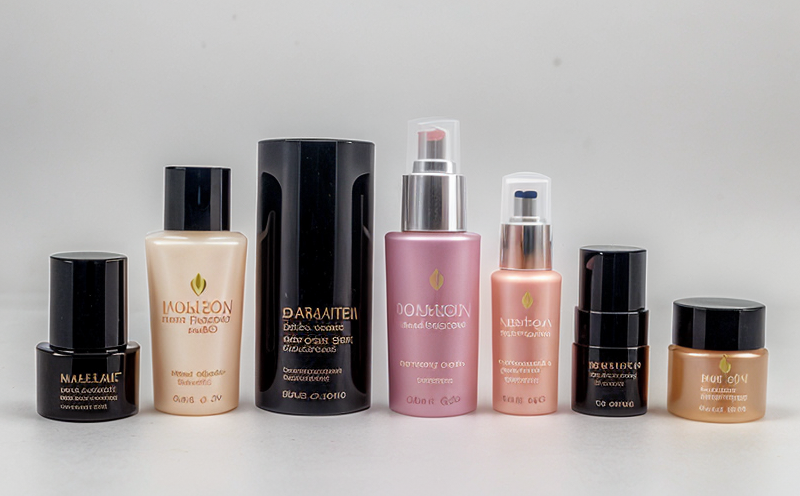Bisphenol A (BPA) Migration Testing in Cosmetics
Understanding Bisphenol A (BPA) migration testing is crucial for quality managers and compliance officers within the cosmetics sector. BPA, a widely used industrial chemical, can migrate from packaging materials into cosmetic products under certain conditions. This migration poses potential health risks, particularly when it comes to prolonged or frequent use of such products.
The testing process involves several critical steps, including the selection of appropriate test specimens and the application of standardized methods. According to ISO 18963-2:2015, which specifies the procedure for determining BPA migration from packaging into food contact materials, the testing protocol is well-defined. The method typically involves submerging the packaging material in a solvent such as ethanol or water, followed by analysis of the extract.
The importance of this test cannot be overstated. BPA, when ingested through contaminated products, can disrupt endocrine systems and lead to various health issues. Compliance with regulations like the European Union's REACH Directive (Registration, Evaluation, Authorization and Restriction of Chemicals) is paramount for manufacturers seeking to sell their products in Europe.
To ensure accurate results, it is essential that laboratories follow precise procedures. Specimen preparation involves selecting representative samples from production batches, ensuring they are free from contaminants that could affect test outcomes. The apparatus used includes high-performance liquid chromatography (HPLC) with photodiode array detection (PDA), which provides a sensitive and reliable means of detecting BPA.
Acceptance criteria for the test include limits set by regulatory bodies such as the U.S. Food and Drug Administration (FDA). For instance, the FDA sets a limit of 10 parts per billion (ppb) for BPA in infant formula containers. Compliance with these standards is critical to avoid product recalls and potential legal action.
Manufacturers must also consider the implications of BPA migration on their brand reputation and consumer trust. Non-compliance can lead to significant financial losses due to product recalls, lawsuits, and damage to brand image. Therefore, implementing robust testing protocols early in the development process is advisable.
Why It Matters
The importance of Bisphenol A (BPA) migration testing extends beyond compliance with regulations. It plays a vital role in ensuring consumer safety and maintaining brand reputation. Regulatory bodies worldwide, including the FDA and EU authorities, have stringent limits on BPA levels in packaging materials that come into contact with food and beverages.
- Health Risks: BPA can disrupt hormone levels, particularly affecting children and pregnant women.
- Legal Compliance: Non-compliance with regulations can lead to hefty fines and legal disputes.
- Brand Reputation: A single recall due to BPA contamination can severely damage a brand's image and customer trust.
The testing process itself is rigorous, involving precise specimen preparation and the use of advanced analytical techniques. Compliance officers should ensure that their laboratories adhere strictly to these protocols to meet regulatory requirements.
Quality and Reliability Assurance
Ensuring the quality and reliability of Bisphenol A (BPA) migration testing is essential for maintaining high standards in the cosmetics industry. Compliance officers play a crucial role in overseeing this process, ensuring that all specimens are prepared correctly and tested according to international standards.
- Specimen Preparation: Representative samples must be selected from production batches, free from contamination by external factors.
- Analytical Techniques: HPLC with PDA is the preferred method for its sensitivity and reliability in detecting BPA levels.
- Regulatory Compliance: Laboratories must adhere to standards set by organizations such as ISO 18963-2:2015, ensuring consistent and accurate test results.
The testing process is not just about meeting regulatory requirements but also about protecting the well-being of consumers. By adhering to these protocols, manufacturers can ensure that their products are safe for use and maintain a strong reputation in the market.
Customer Impact and Satisfaction
The impact of Bisphenol A (BPA) migration testing on customer satisfaction is significant. Consumers expect cosmetic products to be safe, especially those used by children or pregnant women. Ensuring that these products do not contain harmful levels of BPA reassures customers and builds trust in the brand.
- Consumer Trust: Compliance with regulations enhances consumer confidence, leading to increased loyalty and repeat purchases.
- Brand Reputation: A commitment to safety through rigorous testing can enhance a brand's reputation and market share.
- Customer Safety: By preventing the migration of harmful substances into cosmetic products, manufacturers protect customer health.
Manufacturers who invest in robust testing protocols not only meet regulatory requirements but also contribute to the overall well-being of their customers. This focus on quality and reliability can significantly enhance customer satisfaction and loyalty.





